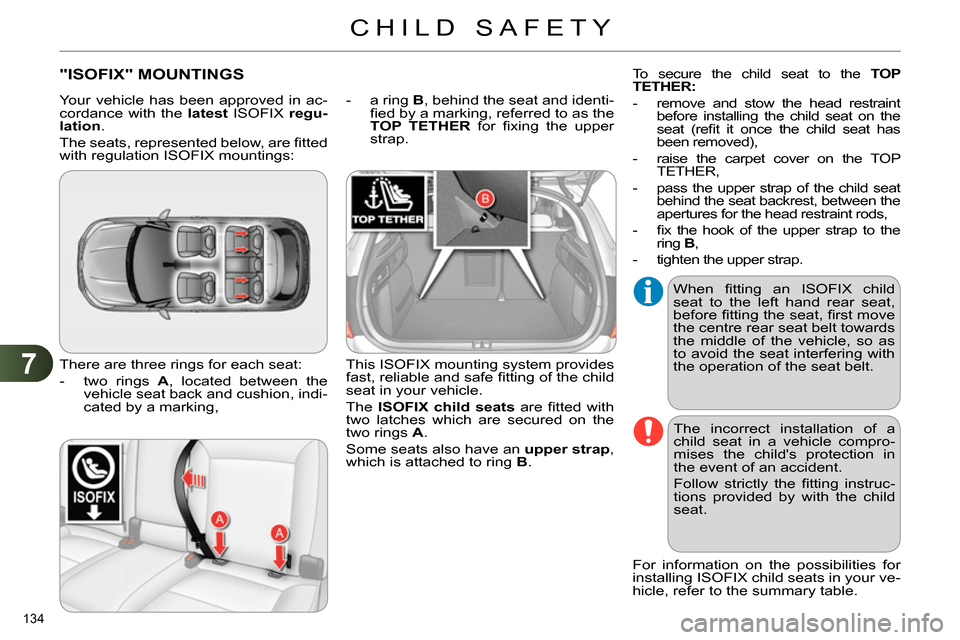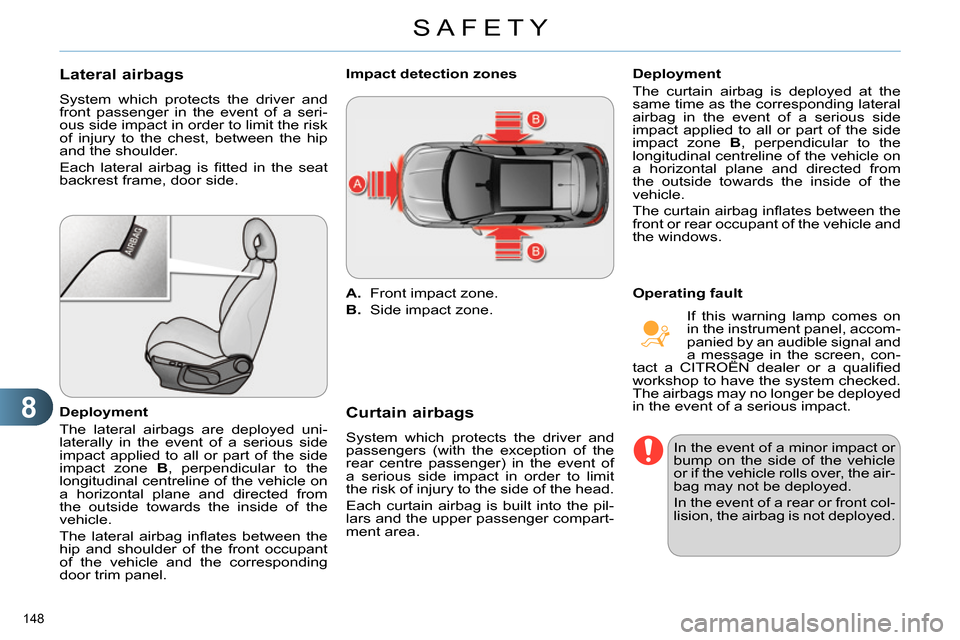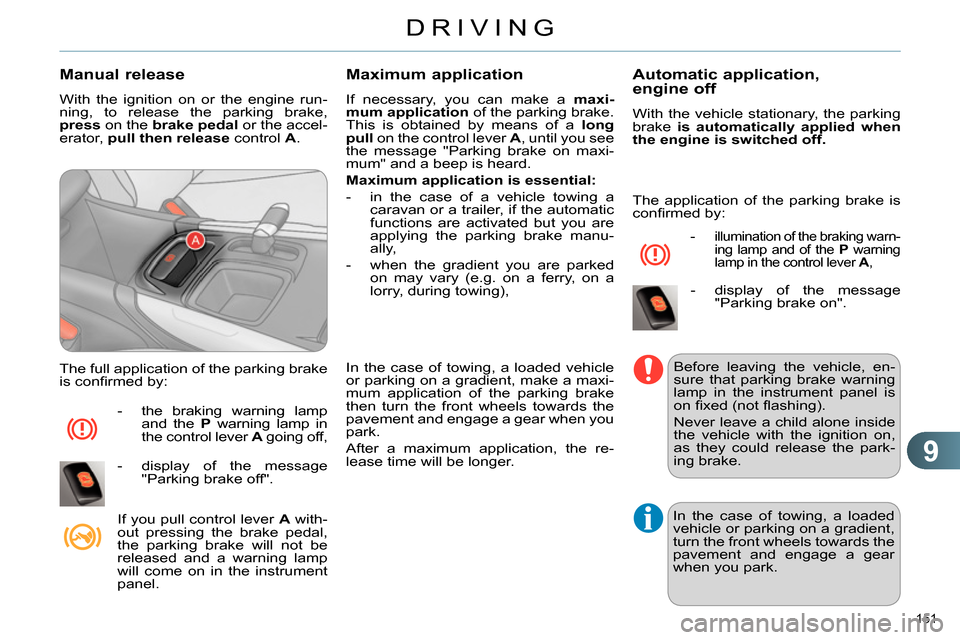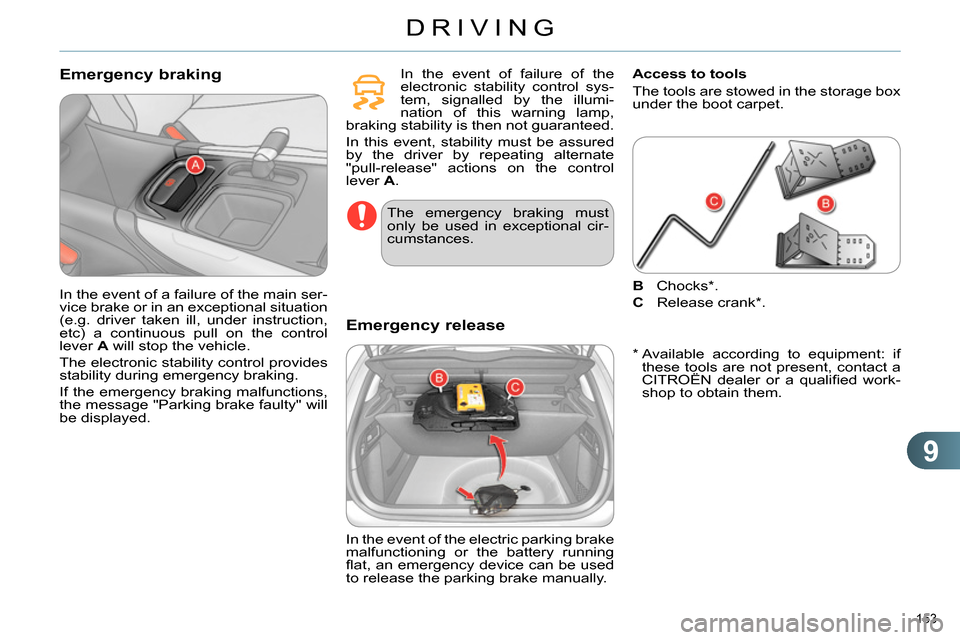tow Citroen C4 2014 2.G Owner's Guide
[x] Cancel search | Manufacturer: CITROEN, Model Year: 2014, Model line: C4, Model: Citroen C4 2014 2.GPages: 340, PDF Size: 28.99 MB
Page 135 of 340

7
CHILD SAFETY
133
(a) Universal child seat: child seat
which can be installed in all vehicles
using the seat belt.
(b) Group 0: from birth to 10 kg. Infant
car seats and "car cots" cannot be
installed on the front passenger
seat.
(c) Consult the legislation in force in
your country before installing your
child on this seat.
(d) To install a child seat at the rear,
backward or forward facing, move
the front seat forward, then straighten
the backrest to allow enough room
for the child seat and the child's
legs.
Remove and stow the head re-
straint before installing a child
seat with backrest on a passen-
ger seat. Refi t the head restraint
once the child seat has been re-
moved.
U
: seating position suitable for the in-
stallation of a child seat secured
using the seat belt and universally
approved "rearward facing" and/or
"forward facing".
U(R1)
: identical to U
, with the vehicle's
seat backrest inclined fully for-
wards.
U(R2)
: identical to U
, with the vehicle's
seat adjusted to the highest po-
sition.
X
: seating position not suitable for in-
stalling a child seat for the weight
group indicated.
Page 136 of 340

7
CHILD SAFETY
134
"ISOFIX" MOUNTINGS
There are three rings for each seat:
- two rings A
, located between the
vehicle seat back and cushion, indi-
cated by a marking,
- a ring B
, behind the seat and identi-
fi ed by a marking, referred to as the
TOP TETHER
for fi xing the upper
strap.
This ISOFIX mounting system provides
fast, reliable and safe fi tting of the child
seat in your vehicle.
The ISOFIX child seats
are fi tted with
two latches which are secured on the
two rings A
.
Some seats also have an upper strap
,
which is attached to ring B
.
The incorrect installation of a
child seat in a vehicle compro-
mises the child's protection in
the event of an accident.
Follow strictly the fi tting instruc-
tions provided by with the child
seat.
For information on the possibilities for
installing ISOFIX child seats in your ve-
hicle, refer to the summary table.
When fi tting an ISOFIX child
seat to the left hand rear seat,
before fi tting the seat, fi rst move
the centre rear seat belt towards
the middle of the vehicle, so as
to avoid the seat interfering with
the operation of the seat belt.
Your vehicle has been approved in ac-
cordance with the latest
ISOFIX regu-
lation
.
The seats, represented below, are fi tted
with regulation ISOFIX mountings: To secure the child seat to the TOP
TETHER:
- remove and stow the head restraint
before installing the child seat on the
seat (refi t it once the child seat has
been removed),
- raise the carpet cover on the TOP
TETHER,
- pass the upper strap of the child seat
behind the seat backrest, between the
apertures for the head restraint rods,
- fi x the hook of the upper strap to the
ring B
,
- tighten the upper strap.
Page 138 of 340

7
CHILD SAFETY
136
*
Infant car seats and "car cots" cannot be installed on the front passenger seat.
**
The ISOFIX infant car seat, secured on the lower rings of a vehicle ISOFIX seat, occupies two rear seats.
LOCATIONS FOR ISOFIX CHILD SEATS
In accordance with European Regulations, this table indicates the options for installing ISOFIX child seats on seats in the
vehicle fi tted with ISOFIX mountings.
In the case of universal and semi-universal ISOFIX child seats, the ISOFIX size category, determined by a letter from A
to G
, is
indicated on the child seat next to the ISOFIX logo.
IUF:
seat suitable for the installation of an I
sofi x U
niversal seat, " F
orward facing"
secured using the upper strap.
IL-SU:
seat suitable for the installation of an I
sofi x S
emi- U
niversal seat either:
- "rear facing" fi tted with an upper strap or a support leg,
- "forward facing" fi tted with a support leg,
- an infant car seat fi tted with an upper strap or a support leg.
For advice on securing of the upper strap, refer to the paragraph "ISOFIX mountings".
Weight of the child
/indicative age
Less than
10 kg
(group 0)
Up to approx.
6 months
Less than 10 kg
(group 0)
Less than 13 kg
(group 0+)
Up to approx. 1 year
From 9 to 18 kg (group 1)
From approx. 1 to 3 years
Type of ISOFIX child seat
Infant car
seat
*
"rear facing"
"rear facing"
"forward facing"
ISOFIX size category
F
G
C
D
E
C
D
A
B
B1
ISOFIX child seats universal
and semi-universal which
can be installed on the rear
outer seats
IL-SU
**
IL-SU
IL-SU
IUF
IL-SU
Remove and stow the head re-
straint before installing a child
seat with a backrest on a pas-
senger seat. Refi t the head re-
straint once the child seat has
been removed.
Page 141 of 340

8
SAFETY
139
DIRECTION INDICATORS
Left: lower the lighting stalk passing
the point of resistance.
Right: raise the lighting stalk pass-
ing the point of resistance.
HAZARD WARNING LAMPS
Press this button, the direction indi-
cators fl ash.
They can operate with the ignition off.
Automatic operation of hazard
warning lamps
When braking in an emergency, de-
pending on the deceleration, the hazard
warning lamps come on automatically.
They switch off automatically the fi rst
time you accelerate.
You can also switch them off by
pressing the button.
HORN
A visual warning by means of the direc-
tion indicators to alert other road users
to a vehicle breakdown, towing or ac-
cident.
Three fl ashes of the direction
indicators
Press briefl y upwards or down-
wards, without going beyond the
point of resistance; the direction in-
dicators will fl ash 3 times.
If you forget to cancel the di-
rection indicators for more than
twenty seconds, the volume of
the audible signal will increase
if the speed is above 40 mph
(60 km/h). Audible warning system to alert other
road users to an imminent danger.
Press the central part of the multi-
function steering wheel.
Use the horn moderately and
only in the following circum-
stances:
- immediate danger,
- overtaking a cyclist or pe-
destrian,
- approaching a location lacking
visibility.
Page 147 of 340

8
SAFETY
145
The driver must ensure that passen-
gers use the seat belts correctly and
that they are all restrained securely
before setting off.
Wherever you are seated in the ve-
hicle, always fasten your seat belt,
even for short journeys.
Do not interchange the seat belt
buckles as they will not fulfi l their role
fully.
The seat belts are fi tted with an inertia
reel permitting automatic adjustment
of the length of the strap to your size.
The seat belt is stowed automatically
when not in use.
Before and after use, ensure that the
seat belt is reeled in correctly.
The lower part of the strap must be
positioned as low as possible on the
pelvis.
The upper part must be positioned in
the hollow of the shoulder.
The inertia reels are fi tted with an au-
tomatic locking device which comes
into operation in the event of a col-
lision, emergency braking or if the
vehicle rolls over. You can release
the device by pulling fi rmly on the
strap and releasing it so that it reels
in slightly. In order to be effective, a seat belt
must:
- be tightened as close to the body
as possible,
- be pulled in front of you with a
smooth movement, checking that
it does not twist,
-
be used to restrain only one person,
- not bear any trace of cuts or fraying,
- not be converted or modifi ed to
avoid affecting its performance.
In accordance with current safety
regulations, for all repairs on your ve-
hicle, go to a qualifi ed workshop with
the skills and equipment needed,
which a CITROËN dealer is able to
provide.
Have your seat belts checked regu-
larly by a CITROËN dealer or a
qualifi ed workshop, particularly if the
straps show signs of damage.
Clean the seat belt straps with soapy
water or a textile cleaning product,
sold by CITROËN dealers.
After folding or moving a seat or rear
bench seat, ensure that the seat belt
is positioned and reeled in correctly.
Recommendations for children
Use a suitable child seat if the pas-
senger is less than 12 years old or
shorter than one and a half metres.
Never use the same seat belt to se-
cure more than one person.
Never allow a child to travel on your
lap.
In the event of an impact
Depending on the nature and se-
riousness of the impact
, the pre-
tensioning device may be deployed
before and independently of the
airbags. Deployment of the preten-
sioners is accompanied by a slight
discharge of harmless smoke and
a noise, due to the activation of the
pyrotechnic cartridge incorporated in
the system.
In all cases, the airbag warning lamp
comes on.
Following an impact, have the seat
belts system checked, and if neces-
sary replaced, by a CITROËN dealer
or a qualifi ed workshop.
Page 148 of 340

8
SAFETY
146
AIRBAGS
System designed to maximise the safe-
ty of the occupants (with the exception
of the rear centre passenger) in the
event of violent collisions. The airbags
supplement the action of the force-limit-
ing seat belts (with the exception of the
centre rear passenger).
If a collision occurs, the electronic de-
tectors record and analyse the front
and side impacts sustained in the im-
pact detection zones:
- in the case of a serious impact, the
airbags are deployed instantly and
contribute towards better protection
of the occupants of the vehicle (with
the exception of the rear centre pas-
senger); immediately after the im-
pact, the airbags defl ate rapidly so
that they do not hinder visibility or
the exit of the occupants,
- in the case of a minor or rear impact
or in certain roll-over conditions, the
airbags will not be deployed; the
seat belt alone contributes towards
ensuring your protection in these
situations.
The airbags do not operate
when the ignition is switched
off.
This equipment will only deploy
once. If a second impact occurs
(during the same or a subse-
quent accident), the airbag will
not be deployed again.
A.
Front impact zone.
B.
Side impact zone.
Impact detection zones
Deployment of the airbag(s) is
accompanied by a slight emis-
sion of smoke and a noise, due
to the activation of the pyrotech-
nic cartridge incorporated in the
system.
This smoke is not harmful, but
sensitive individuals may experi-
ence slight irritation.
The noise of the detonation may
result in a slight loss of hearing
for a short time.
Front airbags
System which protects the driver and
front passenger in the event of a seri-
ous front impact in order to limit the risk
of injury to the head and thorax.
The driver's airbag is fi tted in the centre
of the steering wheel; the front passen-
ger's airbag is fi tted in the dashboard
above the glove box.
Deployment
The airbags are deployed, except the
passenger's front airbag if it is deactivat-
ed, in the event of a serious front impact
to all or part of the front impact zone A
, in
the longitudinal centreline of the vehicle
on a horizontal plane and directed from
the front to the rear of the vehicle.
The front airbag infl ates between the tho-
rax and head of the front occupant of the
vehicle and the steering wheel, driver's
side, and the dashboard, passenger's
side to cushion their forward movement.
Page 150 of 340

8
SAFETY
148
Lateral airbags
System which protects the driver and
front passenger in the event of a seri-
ous side impact in order to limit the risk
of injury to the chest, between the hip
and the shoulder.
Each lateral airbag is fi tted in the seat
backrest frame, door side.
Deployment
The lateral airbags are deployed uni-
laterally in the event of a serious side
impact applied to all or part of the side
impact zone B
, perpendicular to the
longitudinal centreline of the vehicle on
a horizontal plane and directed from
the outside towards the inside of the
vehicle.
The lateral airbag infl ates between the
hip and shoulder of the front occupant
of the vehicle and the corresponding
door trim panel.
A.
Front impact zone.
B.
Side impact zone.
Impact detection zones
Curtain airbags
System which protects the driver and
passengers (with the exception of the
rear centre passenger) in the event of
a serious side impact in order to limit
the risk of injury to the side of the head.
Each curtain airbag is built into the pil-
lars and the upper passenger compart-
ment area.
Deployment
The curtain airbag is deployed at the
same time as the corresponding lateral
airbag in the event of a serious side
impact applied to all or part of the side
impact zone B
, perpendicular to the
longitudinal centreline of the vehicle on
a horizontal plane and directed from
the outside towards the inside of the
vehicle.
The curtain airbag infl ates between the
front or rear occupant of the vehicle and
the windows.
Operating fault
If this warning lamp comes on
in the instrument panel, accom-
panied by an audible signal and
a message in the screen, con-
tact a CITROËN dealer or a qualifi ed
workshop to have the system checked.
The airbags may no longer be deployed
in the event of a serious impact.
In the event of a minor impact or
bump on the side of the vehicle
or if the vehicle rolls over, the air-
bag may not be deployed.
In the event of a rear or front col-
lision, the airbag is not deployed.
Page 152 of 340

9
DRIVING
150
ELECTRIC PARKING BRAKE
The electric parking brake combines
2 operational modes:
- Automatic Application/Release
Application is automatic when the
engine stops, release is automatic
on use of the accelerator (activated
by default),
- Manual Application/Release
The parking brake can be applied /
released manually by pulling control
lever A
.
If this warning lamp comes on
in the instrument panel, the au-
tomatic mode is deactivated.
Programming the mode
Depending on the country of sale of the
vehicle, the automatic application when
the engine is switched off and the auto-
matic release when you press the ac-
celerator can be deactivated.
It is recommended that you do
not apply the parking brake in
very cold conditions (ice) and
during towing (breakdown, cara-
van...). Deactivate the automatic
functions and release the park-
ing brake manually.
Manual application
With the vehicle stationary, to apply the
parking brake whether the engine is
running or off, pull
control lever A
.
The application of the parking brake is
confi rmed by:
- illumination of the braking warn-
ing lamp and of the P
warning
lamp in the control lever A
,
- display of the message
"Parking brake on".
Before leaving the vehicle, en-
sure that parking brake warning
lamp in the instrument panel is
on fi xed, not fl ashing.
When the driver’s door is opened with
the engine running, a message is dis-
played accompanied by an audible sig-
nal if the parking brake has not been
applied. Activation / deactivation is done
using the vehicle confi guration
menu; refer to the section cov-
ering the confi guration of your
vehicle's systems.
The parking brake is then applied and
released manually. When the driver's
door is opened, there is an audible sig-
nal and a message is displayed if the
brake is not applied.
Do not place any object (packet
of cigarettes, telephone...) be-
tween the gear lever and the
electric parking brake control
lever.
Page 153 of 340

9
DRIVING
151
Manual release
With the ignition on or the engine run-
ning, to release the parking brake,
press
on the brake
pedal
or the accel-
erator, pull then release
control A
.
The full application of the parking brake
is confi rmed by:
- the braking warning lamp
and the P
warning lamp in
the control lever A
going off,
- display of the message
"Parking brake off".
If you pull control lever A
with-
out pressing the brake pedal,
the parking brake will not be
released and a warning lamp
will come on in the instrument
panel.
Maximum application
If necessary, you can make a maxi-
mum application
of the parking brake.
This is obtained by means of a long
pull
on the control lever A
, until you see
the message "Parking brake on maxi-
mum" and a beep is heard.
Maximum application is essential:
- in the case of a vehicle towing a
caravan or a trailer, if the automatic
functions are activated but you are
applying the parking brake manu-
ally,
- when the gradient you are parked
on may vary (e.g. on a ferry, on a
lorry, during towing),
In the case of towing, a loaded vehicle
or parking on a gradient, make a maxi-
mum application of the parking brake
then turn the front wheels towards the
pavement and engage a gear when you
park.
After a maximum application, the re-
lease time will be longer.
Automatic application,
engine off
With the vehicle stationary, the parking
brake is automatically applied when
the engine is switched off.
- illumination of the braking warn-
ing lamp and of the P
warning
lamp in the control lever A
,
- display of the message
"Parking brake on".
Before leaving the vehicle, en-
sure that parking brake warning
lamp in the instrument panel is
on fi xed (not fl ashing).
Never leave a child alone inside
the vehicle with the ignition on,
as they could release the park-
ing brake.
In the case of towing, a loaded
vehicle or parking on a gradient,
turn the front wheels towards the
pavement and engage a gear
when you park.
The application of the parking brake is
confi rmed by:
Page 155 of 340

9
DRIVING
153
Emergency braking
In the event of failure of the
electronic stability control sys-
tem, signalled by the illumi-
nation of this warning lamp,
braking stability is then not guaranteed.
In this event, stability must be assured
by the driver by repeating alternate
"pull-release" actions on the control
lever A
.
In the event of a failure of the main ser-
vice brake or in an exceptional situation
(e.g. driver taken ill, under instruction,
etc) a continuous pull on the control
lever A
will stop the vehicle.
The electronic stability control provides
stability during emergency braking.
If the emergency braking malfunctions,
the message "Parking brake faulty" will
be displayed.
The emergency braking must
only be used in exceptional cir-
cumstances.
Emergency release
In the event of the electric parking brake
malfunctioning or the battery running
fl at, an emergency device can be used
to release the parking brake manually.
Access to tools
The tools are stowed in the storage box
under the boot carpet.
* Available according to equipment: if
these tools are not present, contact a
CITROËN dealer or a qualifi ed work-
shop to obtain them.
B
Chocks*.
C
Release crank*.